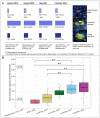Virus-Host Dynamics in Archaeal Groundwater Biofilms and the Associated Bacterial Community Composition
- PMID: 37112890
- PMCID: PMC10143303
- DOI: 10.3390/v15040910
Virus-Host Dynamics in Archaeal Groundwater Biofilms and the Associated Bacterial Community Composition
Abstract
Spatial and temporal distribution of lytic viruses in deep groundwater remains unexplored so far. Here, we tackle this gap of knowledge by studying viral infections of Altivir_1_MSI in biofilms dominated by the uncultivated host Candidatus Altiarchaeum hamiconexum sampled from deep anoxic groundwater over a period of four years. Using virus-targeted direct-geneFISH (virusFISH) whose detection efficiency for individual viral particles was 15%, we show a significant and steady increase of virus infections from 2019 to 2022. Based on fluorescence micrographs of individual biofilm flocks, we determined different stages of viral infections in biofilms for single sampling events, demonstrating the progression of infection of biofilms in deep groundwater. Biofilms associated with many host cells undergoing lysis showed a substantial accumulation of filamentous microbes around infected cells probably feeding off host cell debris. Using 16S rRNA gene sequencing across ten individual biofilm flocks from one sampling event, we determined that the associated bacterial community remains relatively constant and was dominated by sulfate-reducing members affiliated with Desulfobacterota. Given the stability of the virus-host interaction in these deep groundwater samples, we postulate that the uncultivated virus-host system described herein represents a suitable model system for studying deep biosphere virus-host interactions in future research endeavors.
Keywords: Altiarchaeota; deep biosphere; direct-geneFISH; fluorescence in situ hybridization; microbial heterogeneity; subsurface viruses; virusFISH.
Conflict of interest statement
The authors declare no conflict of interest.
Figures




References
-
- Proctor L., Fuhrman J. Mortality of Marine Bacteria in Response to Enrichments of the Virus Size Fraction from Seawater. Mar. Ecol. Prog. Ser. 1992;87:283–293. doi: 10.3354/meps087283. - DOI
Publication types
MeSH terms
Substances
LinkOut - more resources
Full Text Sources
Miscellaneous

